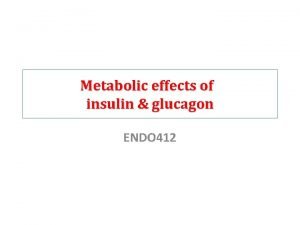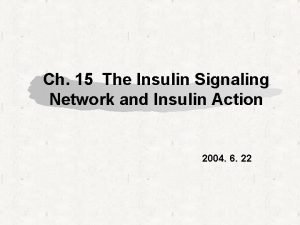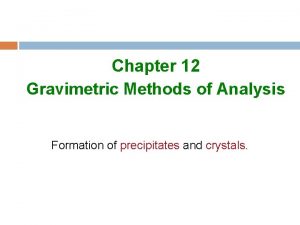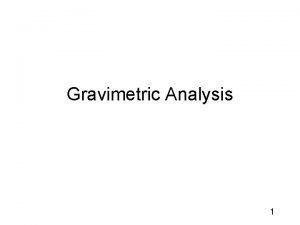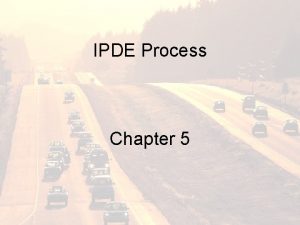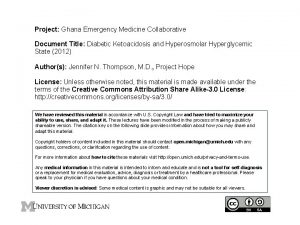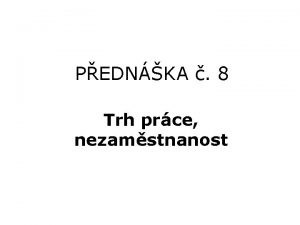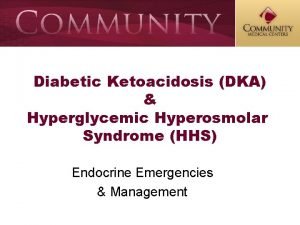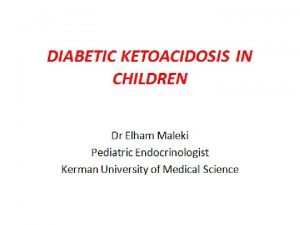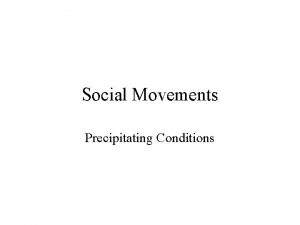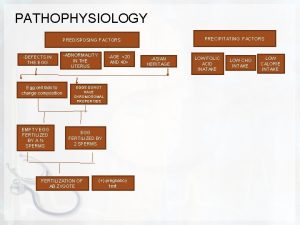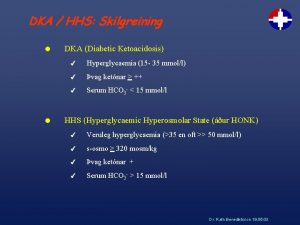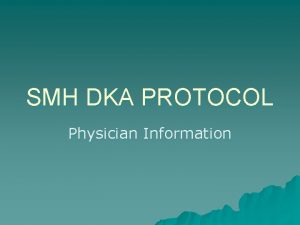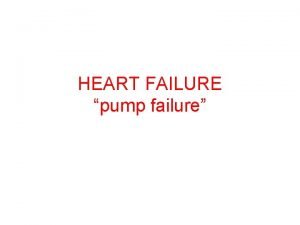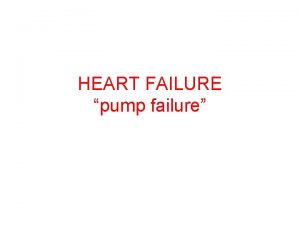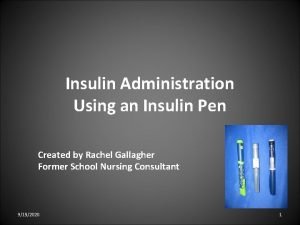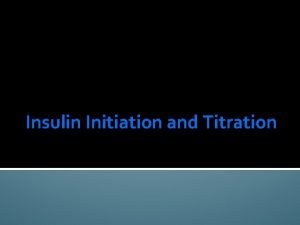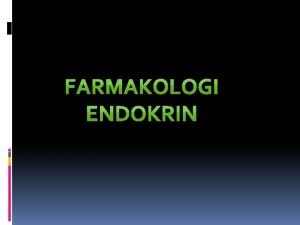DKA DKA Precipitating Factors Failure to take insulin

























- Slides: 25

DKA

DKA Precipitating Factors • Failure to take insulin • Failure to increase insulin – Illness/Infection • Pneumonia • MI • Stroke – Acute stress • Trauma • Emotional • Medical Stress – Counterregulatory hormones • Oppose insulin • Stimulate glucagon release • Hypovolmemia – Increases glucagon and catecholamines • Decreased renal blood flow • Decreases glucagon degradation by the kidney

Diabetic Ketoacidosis Due to: Severe insulin deficiency Excess counterregulatory hormones Glucagon Epinephrine Cortisol Growth hormone

Role of Insulin • Required for transport of glucose into – Muscle – Adipose – Liver • Inhibits lipolysis • Absence of insulin – Glucose accumulates in the blood – Liver • Uses amino acids for gluconeogenesis • Converts fatty acids into ketone bodies – Acetone, Acetoacetate, β-hydroxybutyrate – Increased counterregulatory hormones

Counterregulatory Hormones - DKA Epinephrine Increases insulin resistance Activates glycogenolysis and gluconeogenesis Activates lipolysis Inhibits insulin secretion X X X Glucagon X Cortisol X Growth Hormone X X

Insulin Deficiency Glucose uptake Lipolysis Proteolysis Glycerol Free Fatty Acids Amino Acids Hyperglycemia Osmotic diuresis Gluconeogenesis Glycogenolysis Ketogenesis Dehydration Acidosis

Signs and Symptoms of DKA • Polyuria, polydipsia – Enuresis • Dehydration – Tachycardia – Orthostasis • Abdominal pain – Nausea – Vomiting • Fruity breath – Acetone • Kussmaul breathing • Mental status changes – Combative – Drunk – Coma

Lab Findings • Hyperglycemia • Anion gap acidosis – (Na + K) – (Cl + Bicarb) >12 – Bicarbonate <15 m. Eq/L – p. H <7. 3 • Urine ketones and serum ketones • Hyperosmolarity

Differential Diagnosis Anion Gap Acidosis • • • Alcoholic ketoacidosis Lactic acidosis Renal failure Ethylene glycol or methyl alcohol poisoning Starvation in late pregnancy or lactation (rare)

Atypical Presentations • DKA can be present with BS <300 – Impaired gluconeogenesis • • Liver disease Acute alcohol ingestion Prolonged fasting Insulin-independent glucose is high (pregnancy) – Chronic poor control but taking insulin • Bedside urine ketones false negatives – Measure acetoacetate not β-hydroxybutyrate – Send blood to lab

Treatment of DKA Fluids and Electrolytes • Fluid replacement – Restores perfusion of the tissues • Lowers counterregulatory hormones – Average fluid deficit 3 -5 liters • Initial resuscitation – 1 -2 liters of normal saline over the first 2 hours – Slower rates of 500 cc/hr x 4 hrs or 250 cc/hr x 4 hours • When fluid overload is a concern • If hypernatremia develops ½ NS can be used

Treatment of DKA Fluids and Electrolytes • Hyperkalemia initially present – Resolves quickly with insulin drip – Once urine output is present and K<5. 0, add 20 -40 meq KCL per liter. • Phosphate deficit – May want to use Kphos • Bicarbonate not given unless p. H <7 or bicarbonate <5 mmol/L

Treatment of DKA Insulin Therapy • IV bolus of 0. 1 -0. 2 units/kg (~ 10 units) regular insulin • Follow with hourly regular insulin infusion • Glucose levels – Decrease 75 -100 mg/dl hour – Minimize rapid fluid shifts • Continue IV insulin until urine is free of ketones

Treatment of DKA Glucose Administration • Supplemental glucose – Hypoglycemia occurs • Insulin has restored glucose uptake • Suppressed glucagon – Prevents rapid decline in plasma osmolality • Rapid decrease in insulin could lead to cerebral edema • Glucose decreases before ketone levels decrease • Start glucose when plasma glucose <300 mg/dl

Insulin-Glucose Infusion for DKA Blood glucose <70 70 -100 101 -150 Insulin Infusion 0. 5 units/hr 1. 0 2. 0 D 5 W Infusion 150 cc/hr 125 100 151 -200 201 -250 251 -300 301 -350 351 -400 401 -450 451 -500 >500 3. 0 4. 0 6. 0 8. 0 10. 0 12. 0 15. 0 20. 0 100 75 50 0 0

Complications of DKA • Infection – Precipitates DKA – Fever – Leukocytosis can be secondary to acidosis • Shock – If not improving with fluids r/o MI • Vascular thrombosis – Severe dehydration – Cerebral vessels – Occurs hours to days after DKA • Pulmonary Edema – Result of aggressive fluid resuscitation • Cerebral Edema – – First 24 hours Mental status changes Tx: Mannitol May require intubation with hyperventilation

Once DKA Resolved Treatment • Most patients require 0. 5 -0. 6 units/kg/day • Pubertal or highly insulin resistant patients – 0. 8 -1. 0 units/kg/day • Long acting insulin – 1/2 -2/3 daily requirement – NPH, Lente, Ultralente or Lantus • Short acting insulin – 1/3 -1/2 given at meals – Regular, Humalog, Novolog • Give insulin at least 2 hours prior to weaning insulin infusion.

Prevention of DKA Sick Day Rules • Never omit insulin – Cut long acting in half • • • Prevent dehydration and hyperglycemia Monitor blood sugars frequently Monitor for ketosis Provide supplemental fast acting insulin Treat underlying triggers Maintain contact with medical team

Hyperosmolar Non-ketotic Syndrome • Extreme hyperglycemia and dehydration – Unable to excrete glucose as quickly as it enters the extracellular space – Maximum hepatic glucose output results in a plateau of plasma glucose no higher than 300500 mg/dl – When sum of glucose excretion plus metabolism is less than the rate which glucose enters extracellular space.

Hyperosmolar Non-ketotic Syndrome • Extreme hyperglycemia and hyperosmolarity • High mortality (12 -46%) • At risk – Older patients with intercurrent illness – Impaired ability to ingest fluids • Urine volume falls – Decreased glucose excretion • Elevated glucose causes CNS dysfunction and fluid intake impaired • No ketones – Some insulin may be present – Extreme hyperglycemia inhibits lipolysis

Hyperosmolar Nonketotic Syndrome Presentation • • Extreme dehydration Supine or orthostatic hypotension Confusion coma Neurological findings – Seizures – Transient hemiparesis – Hyperreflexia – Generalized areflexia

Hyperosmolar Nonketotic Syndrome Presentation • Glucose >600 mg/dl • Sodium – Normal, elevated or low • Potassium – Normal or elevated • Bicarbonate >15 m. Eq/L • Osmolality >320 m. Osm/L • Creatinine may increased

Hyperosmolar Nonketotic Syndrome Treatment • Fluid repletion – NS 2 -3 liters rapidly – Total deficit = 10 liters • Replete ½ in first 6 hours • Insulin – Make sure perfusion is adequate – Insulin drip 0. 1 U/kg/hr • Treat underlying precipitating illness

Clinical Errors • Fluid shift and shock – Giving insulin without sufficient fluids – Using hypertonic glucose solutions • Hyperkalemia – Premature potassium administration before insulin has begun to act • Hypokalemia – Failure to administer potassium once levels falling • Recurrent ketoacidosis – Premature discontinuation of insulin and fluids when ketones still present • Hypoglycemia – Insufficient glucose administration

Conclusion • Successful management requires – Judicious use of fluids • Establish good perfusion – Insulin drip • Steady decline • Complete resolution of ketosis – Electrolyte replacement – Frequent neurological evaluations – High suspicion for complications • Determine etiology to avoid recurrent episodes
 3 reasons for supportive stance
3 reasons for supportive stance What are the 5 stages of the verbal escalation continuum
What are the 5 stages of the verbal escalation continuum Precipitating factors meaning
Precipitating factors meaning 4 crisis development behavior levels
4 crisis development behavior levels Effect of insulin on carbohydrate metabolism
Effect of insulin on carbohydrate metabolism Insulin and insulin receptor
Insulin and insulin receptor Brittle fracture examples
Brittle fracture examples Capture beat
Capture beat Pacer failure to sense
Pacer failure to sense Inorganic precipitating agents
Inorganic precipitating agents Example of post precipitation
Example of post precipitation Aqueous ionic equilibrium
Aqueous ionic equilibrium Inclusion in gravimetric analysis
Inclusion in gravimetric analysis Occlusion in gravimetric analysis
Occlusion in gravimetric analysis Factors of project success and failure
Factors of project success and failure Take a bus or take a train
Take a bus or take a train What factors can cause the ipde process to take more time?
What factors can cause the ipde process to take more time? Calculate fluid deficit
Calculate fluid deficit Criteria dka
Criteria dka Portland protocol dka
Portland protocol dka Nab��dka pr��ce praha 6
Nab��dka pr��ce praha 6 Dka vs hhs
Dka vs hhs Hhs vs dka
Hhs vs dka Bsped dka
Bsped dka Nab��dka pr��ce praha 5
Nab��dka pr��ce praha 5 Hhs vs dka
Hhs vs dka




